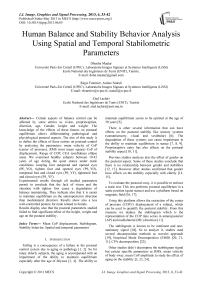Human Balance and Stability Behavior Analysis Using Spatial and Temporal Stabilometric Parameters
Автор: Dhouha Maatar, Régis Fournier, Amine Naitali, Zied Lachiri
Журнал: International Journal of Image, Graphics and Signal Processing(IJIGSP) @ijigsp
Статья в выпуске: 6 vol.5, 2013 года.
Бесплатный доступ
Certain aspects of balance control can be affected by some entries as vision, proprioception, direction, age, Gender, height and weight. The knowledge of the effects of these factors on postural equilibrium allows differentiating pathological and physiological postural aspects. The aim of this study is to define the effects of these entries on postural control by analyzing the parameters: mean velocity of CoP (center of pressure), RMS (root mean square) CoP of displacement, Range of COP, CEA (confidence ellipse area). We examined healthy subjects between 19-42 years of age during the quiet stance under static conditions: keeping foot outspread and opened eyes (PE_YO), tighten foot and opened eyes (PS_YO), outspread foot and closed eyes (PE_YF), tightened foot and closed eyes (PS_YF). Experimental results through all studied parameters permit to conclude that the lack of vision and the situation with tighten foot cause a degradation of balance maintaining. They indicate also that it is easier to maintain equilibrium on the anteroposterior direction than mediolateral direction. Results show also a less well-controlled posture for male related to female. Results display also that the postural parameters studied failed to find significant effect of the height, weight and age on the postural stability.
Mean CoP displacement, Stabilogram, Stability behavior, Spatial and temporal parameters
Короткий адрес: https://sciup.org/15012870
IDR: 15012870
Текст научной статьи Human Balance and Stability Behavior Analysis Using Spatial and Temporal Stabilometric Parameters
Published Online May 2013 in MECS DOI: 10.5815/ijigsp.2013.06.05
Falling is a consequence of a failure in the postural control system due to aging or pathology [1, 2]. So for many elderly subjects, the aging is accompanied with an impairment of the ability to maintain equilibrium especially after the age of 60years [3, 4]. The ability to maintain equilibrium seems to be optimal at the age of 50 years [5].
There is other several information that can have effects on the postural stability like sensory systems (somatosensory, visual and vestibular) [6]. The degradation of these systems can cause impairment in the ability to maintain equilibrium in stance [7, 8, 9]. Proprioceptive entry has also effects on the postural stability aspect [10, 11].
Previous studies analyses also the effect of gender on the postural aspect. Some of these studies conclude that there is no relationship between gender and stabilities [12, 13]. However other studies confirmed that gender have effects on the stability especially with elderly [14, 15].
To evaluate the postural sway, it is possible to enforce a static test. This test performs postural equilibrium in a static position (quiet stance) and use a platform based on magnetic field [16, 17].
Using this platform allows the extraction of the center of pressure (COP)’s displacement of a subject, which can be used to quantify the postural stability. From this measure we deduce the stabilogram which is the representation of the COP time series in anteroposterior (AP) and mediolateral (ML) direction [11].
The stabilogram is known to be nonlinear and non-stationary signal [18]. So to analyze it, studies used several decomposition methods as wavelet approach [19], Empirical Mode Decomposition (EMD) [20, 21, 11], CPA decomposition [22].
Other studies didn’t decompose the stabilogram signal but extract specific parameters as RMS, mean velocity of body sway, mean CoP amplitude to study the effect of aging on the stability [3, 23, 24].
The aim of this study is to find the effect of vision, proprioception, direction, age, gender, height and weight to postural behavior, using three parameters: mean CoP velocity, RMS of the CoP displacement, range of the CoP displacement, CEA of the CoP displacement.
This paper is organized as follows: in Section 2, we describe the experimental protocol, the subjects and the spatial and temporal parameters used in this study. Finally, our results and discussions are provided in Section 3.
-
II. M ETHODS , MATERIALS AND MEASURES
The electromagnetic device is based on the use of pulsed magnetic fields. It consists on an antenna with three coils stuck on the earth and a receiver with also three coils that measures simultaneously the three components of electromagnetic signal sprung from the antenna. The device content also an electromagnetic sensor that must be placed on the mass center of subject and indicate the three-dimensional position and orientation of COP.
The coordination between the transmission and the reception part is ensured by the acquisition board linked to the PC [16]. (Fig.1) The interface of the acquisition board manipulation and the calculations are performed using Matlab (The Math Works Inc).
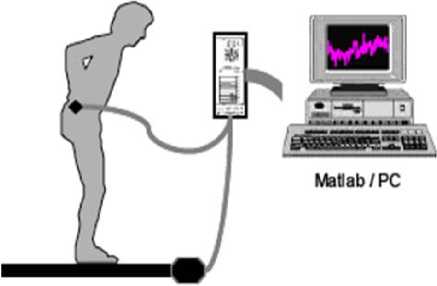
Figure.1: electromagnetic platform [22] .
Due to the use of the electromagnetic field to measures positions, the sensors used are oversensitive to the electromagnetic perturbation especially if metallic object or computers screens with cathodic tube intercept this field. So, the measures obtained present errors due to sensors response nature and the electromagnetic field distortion caused by the environment nature. Because of this distortion we have designed a special equipment calibration in order to correct the field deformation [17].
The calibration phase is fundamental to estimate and correct the error of measures caused by electromagnetic field distortion. This step, allow to collect stabilogram signal measures with a known minimal allowed error.
After calibration and correction phases, one can measure the postural stability in the horizontal plane with a known error. Therefore, the obtained stabilograms represent COP time series in mediolateral (ML) and anterioposterior (AP) directions [11] (Fig.2).
(a)
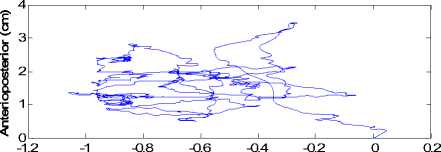
Mediolateral (cm) (b) (c)

0 10 20 30 0 10 20 30
time(s) time(s)
Figure.2: Displacement of the center of pressure in (a)the horizontal plane(b) mediolatéral (ML) direction and (c)Anteroposterior (AP) displacement.
The balance control was assessed by several parameters.
mean COP velocity
The first parameter is mean velocity of CoP in AP and
ML directions (VAP, VML) [4], where:
Vap = ф У I CqPap (n + 1) - СоРдр (n) I

RMS of COP displacement
The second parameter is the RMS of the CoP displacement calculated for AP and ML directions (RMSAP, RMSML), where:

KM>nl - v
Range of COP displacement
The third parameter is Range of COP displacement. It is a quantity defined as the difference between the maximum value (maximum global) and the minimum value (minimum global) of the signal calculated for AP and ML directions (RAP, RML), where:
Rap ■ max (.CqPap) - пйп(СаРлг)
Rnl = max (.СоРщ.) - min(Cofyt}
Confidence ellipse of COP displacement
The fourth parameter is the 95% confidence ellipse area (CEA). It is a method to estimate the confidence area of the COP path that encloses approximately 95% of the points on the COP path, where:
й ^СоР^.СоРхД1
Ш = ---------N1---------Г I---- N----)
Each of these parameters is calculated for the four situations (PE_YF, PE_YO, PS_YF, PS_YO).
A high value for each of these parameters displays degradation in balance maintaining.
-
A. Subjects
Twenty five healthy subjects (8 females and 17 males) participated in the stabilogram acquisition. Information about each subject is provided, namely: name, age, height, weight. The subject’s ages vary between 19 years and 42 years; weights are between 52 and 105 kg and heights vary between 160cm and 192cm.
The subjects are divided, related to age, into:
-
• control group (12 subjects with age varying
between 19 and 24 years)
-
• adult group (13 subjects with age varying between 27 and 42 years)
Related to gender, the subjects are divided into:
-
• female group (8 subjects with age varying between 19 and 30 years)
-
• male group (17 subjects with age varying between 20 and 42 years)
Related to weight, the subjects are divided into:
-
• fat group (13 subjects with weight varying between 72 and 105 kg) thin group (12 subjects with weight varying between 52 and 66 kg)
Related to height, the subjects are divided into:
-
• tall group (14 subjects with height varying between 174 and 192 cm)
-
• small group (11 subjects with height varying between 160 and 172cm)
-
B. Exprimental protocol
Experiences are achieved with subjects placed onto the platform, standing upright with arms by their sides.
In order to display the influence of visual and proprioceptive entries on the postural stability, four types of measures are evaluated for every subject.
V The first measure is tested by keeping foot outspread and opened eyes fixing a point placed on the wall in front of the subject (PE_YO),
V The second measure is evaluated with tighten foot and opened eyes (PS_YO),
V The third measure is with outspread foot and closed eyes (PE_YF),
V The last is measured with tightened foot and closed eyes (PS_YF).
Each group of these four types of measures is gathered in a set and for each subject we extract multiple sets of constitutes a database. During 30 seconds of the recording process, subjects must respect the conditions listed previously by preventing any abnormal moving.
Each recorded signal is sampled at 60Hz. In fact, the frequency band corresponding to the human voluntary movements of limbs is located between 3 and 5 Hz, whereas, when considering involuntary trembling, the frequency band is located between 8 and 10 Hz.
-
III. Results and discussion
-
A. Visual entry effects
Independently of age and gender, there is a difference in all parameters values between all subjects for all situations for AP and ML (Fig.3, Fig.4, Fig.5, Fig.6). The values was greater for closed eyes (YF) than for opened eyes (YO) and this is available for both situations PE and PS and both directions ML and AP These increases are indicative of degradation in the balance due to the effect of visual entry on postural stability: with closed eyes, we are less stable than with opened eyes [11, 12, 25, 26].
-
B. Proprioceptive entry effects
For both directions ML and AP and both visual conditions (YF or YO), the values of all parameters was greater for tighten feet (PS) than for outspread feet (PE) (Fig.3, Fig.4, Fig.5, Fig.6). This result display the effect of proprioceptive entry in the control of postural stability that is in accordance with human physiological nature: The postural stability is better maintained with outspread feet position than with tighten feet position [10, 11].
Generally, body sway increases with degradation of visual, vestibular or somatosensory information [8, 9].
-
C. Directional specificity effects
The results show that all parameter values in ML direction are greater than in AP direction (Fig.3, Fig.4, Fig.5). So, in AP direction, subjects can better control their stability as AP is the direction of their heads and gazes (the visual stimulus is in front of subjects). This is similar to the finding of previous studies [27, 28, 29].
ALL SUBJECTS

-0.2 PE YF PE YO PS YF PS YO
Figure.3: Mean velocity of displacement of the center of pressure for all subjects in the mediolatéral (ML) direction and Anteroposterior (AP) direction.
-
D. Age effects
For all parameters, there is no significant difference in values between adult and control groups for all situations and for AP and ML (Fig.7, Fig.8, Fig.9, Fig.10).
The results of previous studies show that stability is in degradation with age [12, 18, 30]. It is displayed previously that the degradation of stability started after the age of 50 years [5].
Since the population of this study has an age lower than 50 years, there are no relationships between age and stability.
All subjects
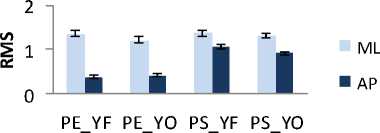
Figure.4: Mean RMS of displacement of the center of pressure for all subjects in the mediolatéral (ML) direction and Anteroposterior (AP) direction.
co
E
i
0.5
ML
111I
control
■ adult
PE YF PE YO PS YF PS YO
-
-
-
—
(a)
AP
all subjects
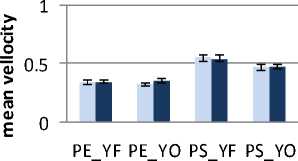
■ adult
control
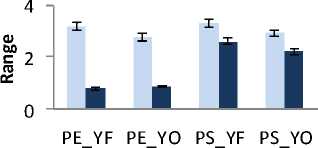
ML
■ AP
Figure.5: Mean range of displacement of the center of pressure for all subjects in the mediolatéral (ML) direction and Anteroposterior (AP) direction.
(b)
Figure.7: Mean velocity of displacement of the center of pressure for control and adult in the (a) mediolatéral (ML) direction and (b)Anteroposterior (AP) direction..
ML
All subjects
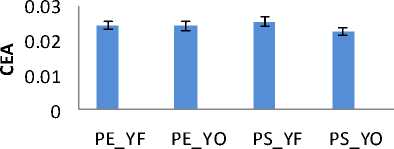
Figure.6: Confidence ellipse area of the center of pressure displacement for all subjects.
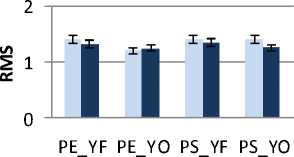
control
■ adult
(a)
АР
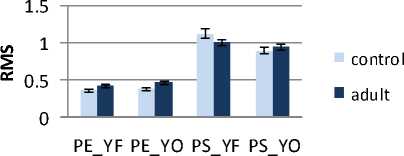
(b)
Figure.8: Mean RMS of displacement of the center of pressure for control and adult in the (a) mediolatéral (ML) direction and (b)Anteroposterior (AP) direction.
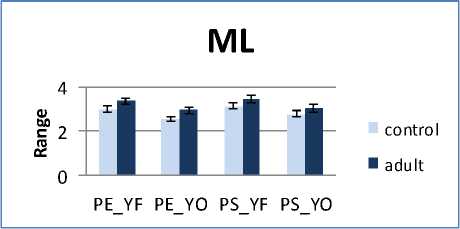
(a)
agreement with many studies that failed to find stability relationship with gender especially with subject’s age between 20 y and 49 y [12, 13]. However, some studies confirmed that there are gender differences in quiet stance especially in retirement age [14, 15].
For the RMS, range, CEA, it is noticed that males values are highly greater than females ones for both AP and ML directions (Fig.12, Fig.13, Fig.14). This indicates that females maintain their postural stability better than males and this is available for subjects aged between 19 and 42 years. This is in agreement with previous studies displaying that Women showed higher standing balance as compared with men ( subjects aged 20-64 years) [31], other studies confirmed that independently of age, men sway more than women [32, 33] .
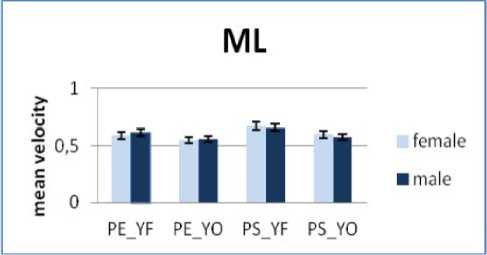
(a)
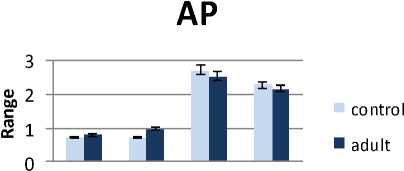
РЕ YF РЕ YO PS YF PS Y0
АР
(b)
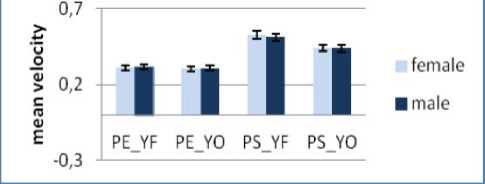
(b)
Figure.9: Mean range of displacement of the center of pressure for control and adult in the (a) mediolatéral (ML) direction and (b) Anteroposterior (AP) direction
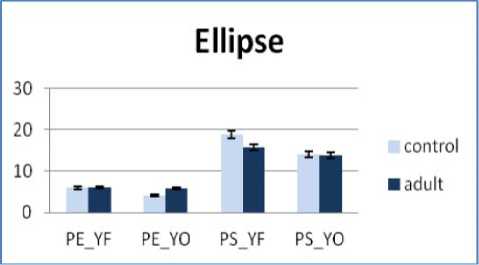
Figure.10: CEA of displacement of the center of pressure for control and adult
Figure.11: Mean velocity of displacement of the center of pressure for female and male in the (a) mediolatéral (ML) direction and (b)Anteroposterior (AP) direction
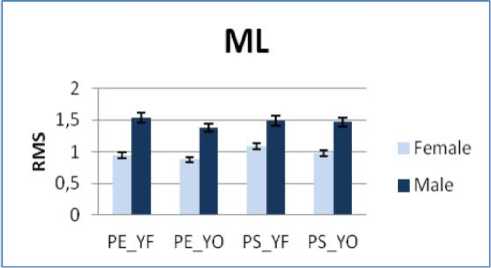
(a)
E. Gender effects
In mean CoP velocity results there is no significant stability relationship with gender (Fig.11). This is in
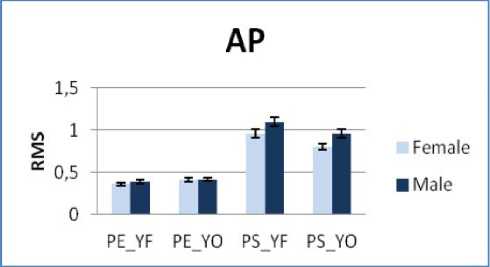
(b)
F. Weight effects
For all parameters, the results show that there are no noticeable differences between fat and thin (Fig.15, Fig.16, Fig.17, Fig.18). Although, previous studies displayed that the increase of weight, so the obesity, causes a decrease in stability [34, 35]. It depends on the population characteristics like the existence of obese person [36]. In our study there is no obese.
ML
Figure.12: Mean RMS of displacement of the center of pressure for female and male in the (a) mediolatéral (ML) direction and (b)Anteroposterior (AP) direction
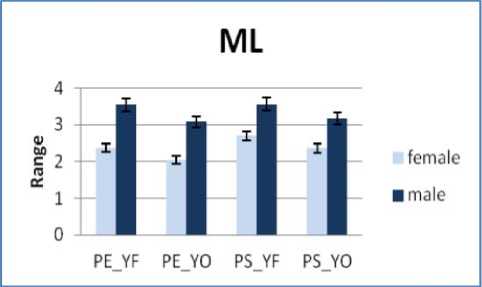
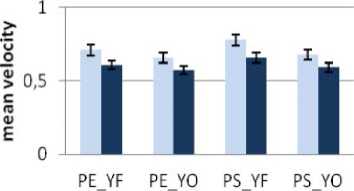
(a)
АР
0,8
(a)
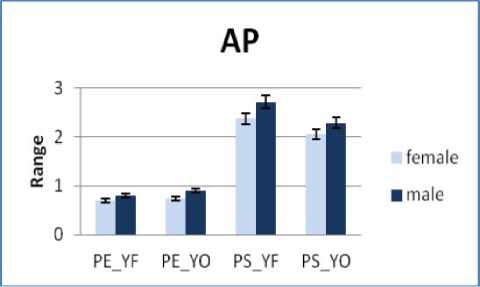
(b)
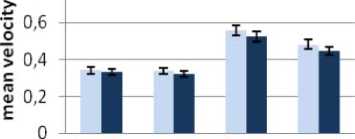
PE YF PE YO PS YF PS YO
(b)
Figure.13: Mean range of displacement of the center of pressure for female and male in the (a) mediolatéral (ML) direction and (b) Anteroposterior (AP) direction
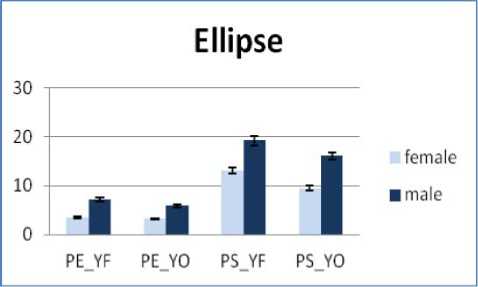
Figure.14: CEA of displacement of the center of pressure for female and male
Figure.15: Mean velocity of displacement of the center of pressure for fat and thin in the (a) mediolatéral (ML) direction and (b)Anteroposterior (AP) direction.
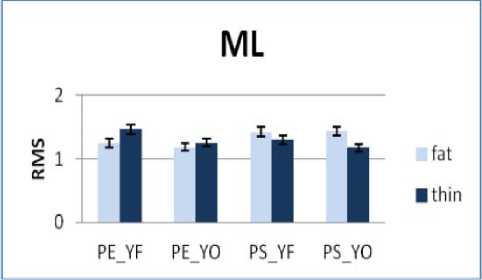
(a)
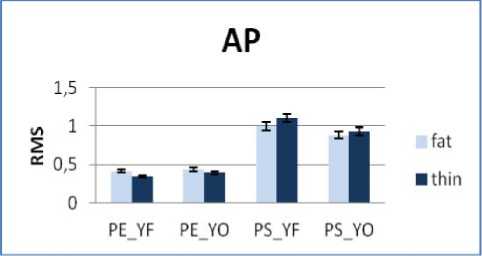
(b)
Figure.16: Mean RMS of displacement of the center of pressure for fat and thin in the (a) mediolatéral (ML) direction and (b)Anteroposterior (AP) direction
G. Height effects
The results show that there are no noticeable differences between tall and small (Fig.19, Fig.20, Fig.21, Fig.22). Although, previous study displaying that more the CoP are away from the surface of platform less the subject is stable, so naturally tall are less stable than small [35].
But since the difference in height between the two groups is not great, these results can be explicated by the effect of the feet length on the stability. In fact, for the tall, the length of feet is greater than for small. So the support surface is greater and this causes a more stability for the tall.
ML
So the effect of the height on the postural stability depends on other factors as feet length.
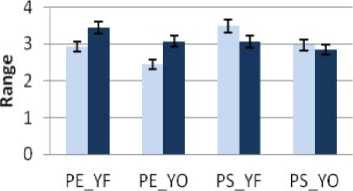
(a)
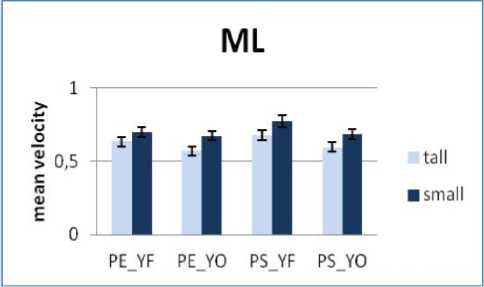
АР
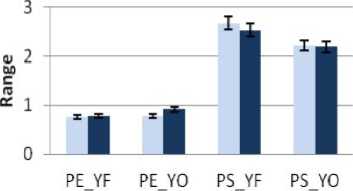
(b)
Figure.17: Mean range of displacement of the center of pressure for fat and thin in the (a) mediolatéral (ML) direction and (b) Anteroposterior (AP) direction
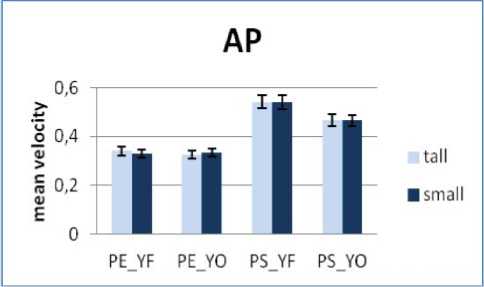
Figure.19: Mean velocity of displacement of the center of pressure for tall and small in the (a) mediolatéral (ML) direction and (b)Anteroposterior (AP) direction
Ellipse
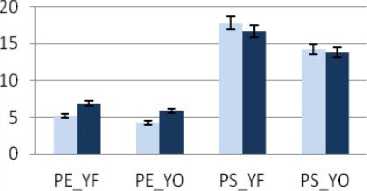
Figure.18: CEA of displacement of the center of pressure for fat and thin
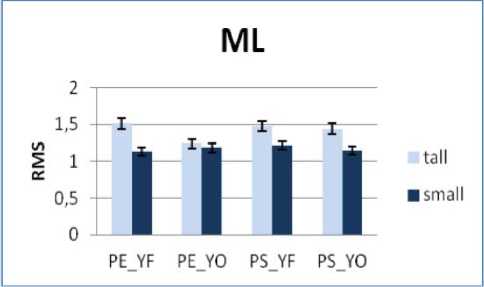
(a)
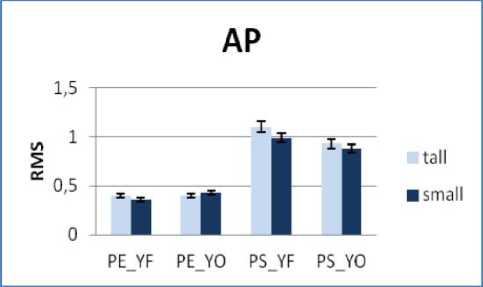
(b)
-
IV. Conclusion
In this study, we studied the effects of certain entries on the human stability behavior. For this we used the parameters: mean velocity of CoP (center of pressure), RMS (root mean square) CoP of displacement, Range of COP, CEA (confidence ellipse area).
Figure.20: Mean RMS of displacement of the center of pressure for tall and small in the (a) mediolatéral (ML) direction and (b)Anteroposterior (AP) direction
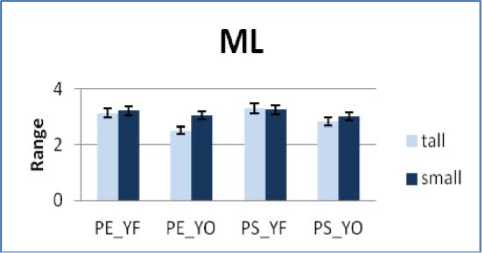
The calculation of these parameters for all subjects for AP and ML directions for all situations (PE_YF, PE_YO, PS_YF and PS_YO) enable to characterize the postural stability system. It showed the effects of directions, visual and proprioceptive entries, the age, the gender, the height and the weight on the stability equilibrium and postural behavior, it was also able to identify the difference in postural control between female and male subjects.
Список литературы Human Balance and Stability Behavior Analysis Using Spatial and Temporal Stabilometric Parameters
- Davis JR, Campbell AD, Adkin AL, Carpenter MG. The relationship between fear of falling and human postural control, Gait Posture 29:275–279, 2009.
- Amoud H, Snoussi H, Hewson D, Duchêne J. Univariate and Bivariate Empirical Mode Decomposition for Postural Stability Analysis, accepted to EURASIP Journal on Advances in Signal. Processing, 2008.
- Abrahamová D, Hlavačka F. Age-Related Changes of Human Balance during Quiet Stance. Physiol. Res. 57: 957-964, 2008.
- Prieto TE, Myklebust JB, Hoffman RG, Lovett EG, Myklebust BM. Measures of postural steadiness: Differences between healthy young and elderly adults. IEEE Trans Biomed Eng 43: 956-966, 1996.
- Hytönen M, Pyykkö I, Aalto H, Starck J. Postural control and age, Acta Otolaryngol (Stockh) 113: 119-122, 1993.
- Gagey PM, Weber B. Entrées du système postural fin, ED. MASSON,1995.
- Du Pasquier Ra, Blanc Y, Sinnreich M, Landis T, Burkhard P, Vingerhoets Fjg. The effect of aging on postural stability: a cross sectional and longitudinal study. Clin Neurophysiol 33: 213-218, 2003.
- Lord Sr, Menz Hb. Visual contributions to postural stability in older adults. Gerontology 46: 306-310, 2000.
- Hlavačka F, Horak FB. Somatosensory influence on postural response to galvanic vestibular stimulation. Physiol Res 55 (Suppl 1): S121-S127, 2006.
- McIlroy WE, Maki BE. Preferred placement of the feet during quiet stance: development of a standardized foot placement for balance testing, .Clin Biomech, 12:66–70, . 1997.
- Fournier R. Thèse de doctorat de l'université Paris XII, Analyse stochastique modale du signal
- stabilométrique. Application à l'étude de l'équilibre chez l'Homme. Octobre 2002.
- Black FO, Wall C, Rockette H, Kitch R. Normal subject postural sway during the Romberg Test, Am J Otolaryngol, 3: 309–318. 1982.
- Hageman PA, Leibowitz JM, Blanke D. Age and gender effects on postural control measures, Arch Phys Med Rehabil, 76:961-965, 1995.
- Bryant Ec, Trew Me, Bruce Am, Kuisma Rm, Smith Aw. Gender differences in balance performance at the time of retirement. Clin Biomech 20: 330-335, 2005.
- Leslie W, Robert W, Carl A, Derby, Paula A, Lewis N. Gender Differences in the Balance of Healthy Elderly as Demonstrated by Dynamic Posturography. J Gerontol. 1994 Jul;49(4):M160-7.
- Fournier R, Deléchelle E, Lemoine J. Décomposition et analyse du signal stabilométrique, 18e colloque GRETSI'01, Toulouse, 10-13 Septembre 2001.
- Fournier R, Deléchelle E, Lemoine J. Méthodes de calibrage d'un système électromagnétique pour l'étude et l'évaluation de mesure posturale, Revue I.T.B.M.,R.B.M. 2002 ; 23 : 303-315. Editions scientifiques et médicales ELSEVIER SAS.
- Carroll JP, Freedman W. Nonstationary properties of postural sway, Journal of Biomechanics, vol. 26, no. 4-5,pp.
- Chagdes Jr, Rietdyk S, Haddad Jm, Zelaznik Hn, Raman A, Rhea Ck, Silver Ta. Multiple timescales in postural dynamics associated with vision and a secondary task are revealed by wavelet analysis, Experimental brain research, vol. 197, no3, pp. 297-310, 2009.
- Amoud H, Snoussi H, Hewson D, Duchêne J. Hilbert-Huang Transformation : Application to Postural Stability Analysis, IEEE EMBC, Lyon, Aug. 2007.
- Huang N.E., Shen Z., Long SR., M.L.C., Shih H.H., Zheng Q.N., Yen N.C., Tung C.C., Liu H.H. The empirical mode decomposition and the Hilbert spectrum for nonlinear and non-stationary time series analysis, Proc. Roy. Soc. LOND A MAT, 454, pp. 903-995, 1998.
- Fournier R, Deléchelle E, Lemoine J. Stabilogram phase estimation, ISIE'2004 IEEE International Symposium on Industrial Electronics, Ajaccio (France), 4-7 mai, 2004.
- Benjuya N, Melzer I, Kaplanski J. Aging-induced shifts from a reliance on sensory input to muscle contraction during balanced standing. J Gerontol A Biol Sci Med Sci 59: 166-171, 2004.
- Raymakers JA, Samson MM, Verhaar HJ. The assessment of body sway and the choice of the stability parameters. Gait posture 21: 48-58, 2005.
- Thanh-Thuan Leˆ , Zoı¨ Kapoula, Role of ocular convergence in the Romberg quotient, Gait and posture ISSN 0966-6362, vol. 27, no3, pp. 493-500, 2008.
- Perrin Pp, Jeandel C, Perrin Ca, Bene Mc. Influence of visual control, conduction, and central integration on static and dynamic balance in healthy older adults. Gerontology 43: 223-231, 1997.
- Andrea Berensci a.c, Masami Ishihara b, Kuniyasu I, The functionzl role of central and peripheral vision in the control of posture, Gait and Posture 27, 493-500, 2008.
- Balasubramaniam R, Riley M. A., Turvey M.T. Specificity of postural sway to the demands of a precision task, Gait and Posture 11, 12–24, 2000.
- Ivanenko Y. P., Grasso R., Lacquaniti F. Effect of gaze on postural responses to neck proprioceptive and vestibular stimulation in humans. Journal of Physiology , 519.1, pp. 301—314, 1999.
- Cohen L. Time-frequency Analysis. Englewood Cliffs, Prentice Hall, 1995.
- Ekhdahl C, Jarnlo G & Andersson S. Standing balance in healthy subjects. Scand J Rehabil Med 21:187-195, 1989.
- Juntunen J, Ylikoski J, Ojala M, Matikainen E, Ylikoski M, Vaheri E. Postural body sway and exposure to high-energy impulse noise. Lancet 11: 261-264, 1987.
- Ojala M, Matikainen E & Juntunen J. Posturography and the dizzy patient: a neurological study of 133 patients. Acta Neurol Scand 80:118–122, 1989.
- Hue O., Simoneau M., Marcotte, J., Berrigan, F., Doré, J., Marceau, P., Marceau, S., Tremblay, A., Teasdale, N., .Body weight is a strong predictor of postural stability. Gait and Posture, 26 : 32-38, 2007.
- Chiari L., Rocchi L., Capello A. Stabilometric parameters are affected by anthropometry and foot placement. Clin Biomech.,17:666-677, 2002.
- Berrigan F, Simoneau M, Tremblay A, Hue O, Teasdale N. Influence of obesity on accurate and rapid arm movement performed from a standing posture. Int J Obes (Lond);30:1750–1757, 2006.

